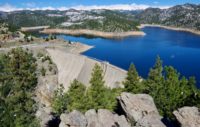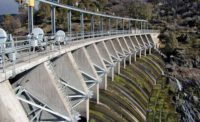What is touted as a record-size U.S. dam removal, held up by 15 years of stakeholder and government legal disputes, now is moving forward, with an April 24 design-build contract to Kiewit Infrastructure West.
The firm will remove four hydroelectric dams on the Klamath River in California and Oregon, allowing it to flow freely with fish passage restored. The project, for Klamath River Renewal Corp., is estimated at $400 million, but Kiewit is currently under an $18.1-million preliminary services award and will develop a guaranteed maximum price by January.
KRRC spokesman Matt Cox termed the project the largest dam removal in U.S. history.
Kiewit’s bid was selected over ones from Granite Construction and Barnard Construction, which also were short-listed.
“Kiewit’s entire package was the most compelling,” Cox says, but did not elaborate. KRRC cited its completion of emergency spillway reconstruction at California’s Oroville Dam.
Progressive Design-Build
The dams now set for removal—J.C. Boyle in Oregon and Copco I, Copco II and Iron Gate in California—were built between 1918 and 1962 and have an aggregate hydroelectric capacity of 43 MW.
Three upper Klamath dams in Oregon will still operate. The seven Klamath dams produce a total of 169 MW.
Kiewit was selected using stepped, or “progressive,” design-build, in which selection is based on qualifications followed by a process that moves toward a design and contract price. The second phase includes final design, construction, commissioning and land restoration.
Kiewit’s initial contract will include design, permitting support and reservoir drawdown preparation. The developed GMP must be submitted to the Federal Energy Regulatory Commission, which must then approve transfer of the dam system’s license by utility owner PacifiCorp to KRRC.
Project implementation is contingent on that approval and other permits. FERC requires KRRC to demonstrate its capacity to undertake the project. The GMP, to be developed when 60% of detailed design is done, “is one piece of data FERC looks at,” says Cox.
The contract also requires local and tribal business participation.
Long history
The removal project stems from a 2016 PacifiCorp agreement with Oregon and California regulators and stakeholders over environmental conditions, in a dispute that began in 2004, when the utility moved to relicense the dams before transferring them to KRRC.
The license expired in 2006, with the dams operating under interim annual licenses since.
A federal appeals court in Washington, D.C., on April 26 upheld a January ruling that the two states waived their water-quality impact authority for the dams by agreeing to withdraw license applications and resubmit them to FERC every year. That process was meant to extend time needed to certify water quality beyond the federally required one year.
Environmentalists, who sought the court rehearing, claimed its January ruling will exempt dozens of dams and other projects from meeting water-quality standards before a FERC license is granted. They have until July to seek U.S. Supreme Court review.






Post a comment to this article
Report Abusive Comment